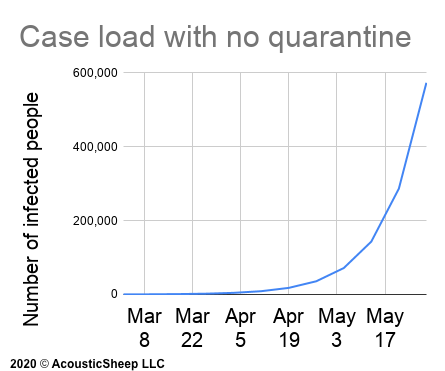Coronavirus Predictions and Business Impact: How Fast It Will Spread, Creating a Business Continuity Plan, and What You Should Stock Up On
February 28, 2020 Wei-Shin Lai, M.D.
Corrections and clarifications made on March 14, 2020 as more information became available.
Running Updates on the Coronavirus Situation

My Background and Qualifications
For 10 years after graduating high school, I studied to become an EIS (epidemic intelligence service) officer with the CDC. When I finally got the job offer as a fully-trained, licensed, board-certified doctor, I had to turn it down for various reasons. It was the hardest decision of my life. Every time there is an epidemic (Ebola, SARS), I look back on that decision and wonder what I would be doing if I was in the midst of directing the epidemic.
Now as a business owner, I have been obsessively following the Coronavirus pandemic. We have over 20 employees in our 13-year-old business, and we ship our SleepPhones® headphones all over the world from Erie, PA, USA. Our supply chain and customers are global, so we really have to think through everything to determine the impact of the Coronavirus on our business. Business continuity through the outbreak is likely on every business owner's mind, and I am uniquely qualified to offer my opinions on this topic. When I asked business owners what questions they had on Facebook, the questions were far more general than I expected. Here is my Facebook Q&A session about the coronavirus. I also published Updates on the Coronavirus Situation. The following article focuses on my rough Coronavirus predictions and business considerations.
Confirmed Cases and Mortality Rates of COVID-19
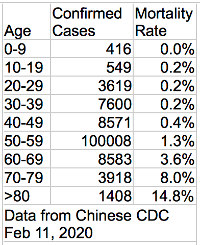
The current Coronavirus outbreak started in Wuhan, China in December 2019, likely at an animal market. It causes symptoms that resemble a bad cold (actually, more like a bad fever, cough, and fatigue, with not much runny/stuffy nose) in most people under age 70. In kids, it may not cause obvious symptoms. People over 70, especially those with heart disease, diabetes, and lung disease are at far higher risk of severe illness and death. To say that the mortality rate is 2% would be over-simplifying it in a negligent way. Here is an informative chart showing the mortality rate per age. No one (zero) under 14 has died, and nearly 15% of people over 80 die. This is really important to understand.
The next thing to understand is what a confirmed case and the mortality rate really means. It's all about the denominator.
- If you don't test, you have no cases. 0/0 = 0% mortality
- If you test only people who show up really sick at the hospital, you'll have a few cases but a high mortality rate. 5/10 = 50% mortality
- If you test everyone with cold symptoms going to the doctor, you'll detect a ton more cases but now have a lower mortality rate. 10/100 = 10% mortality
- If you stand at the entrance of every building and test everyone going in and out with a fever, you will find even more cases, lower mortality still. 20 deaths / 1000 confirmed infected people = 2% mortality (This is what China is doing
nowFebruary 28. As of mid-March, they are only scanning temperature once a day when people report to work in the Shenzhen area, where there have been no new cases lately.) - If you test every single person in a town, we can only guess that there would be even lower mortality. 20 deaths / 1500 confirmed infected people = 1.3% mortality South Korea has come closest to this, so we will look to their mortality rates to make projections.
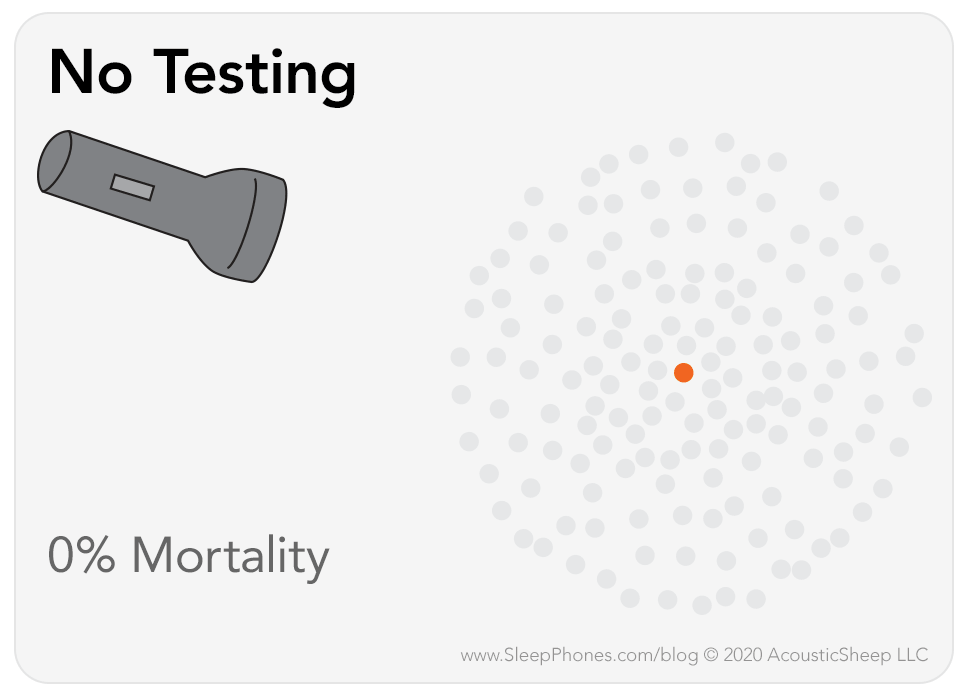
Coronavirus Versus the Flu
The current Coronavirus outbreak (COVID-19) is constantly being compared to the seasonal flu (influenza). While it's a similar benchmark to begin thinking through what to expect, it's really not even close.
The key point here is a different denominator. With influenza, the number susceptible to catching it every year is far less than with COVID-19. Each year, the flu changes slightly. If you've caught one version of the flu, you may be less susceptible to catching another version or have a much milder disease. About 30-40% of people get the flu vaccine as well. So the back-of-a-napkin number of people who are actually susceptible to catching the flu is about 50% of the population. The mortality rate once you catch the flu is about 0.1%.
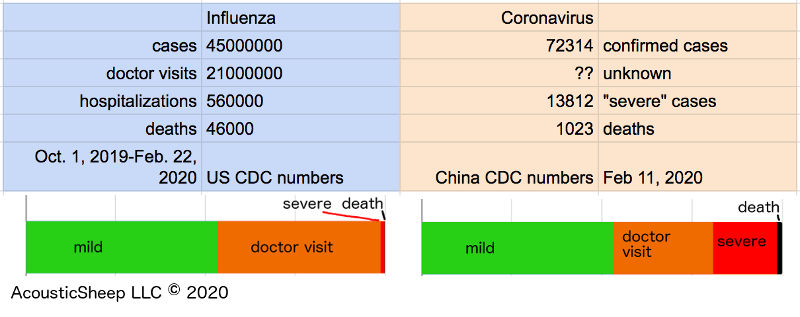
With COVID-19, it appears that pretty much everyone is susceptible. The current mortality rate is 2%. Generally 2-3 times that number will need hospitalization to recover. (We know for sure now that it's closer to 10 times the mortality rate will need hospitalization to recover. Most people over 70, and nearly everyone over 80 years of age will need hospitalization to pull through. There will be lots of younger people too, and when the videos hit social media, it'll be very sobering.)
- Flu: 0.1% mortality * 2.5 rate of hospitalization for 10,000 susceptible people would be 25 people needing hospitalization.
- COVID-19: 2% mortality * 2.5 rate of hospitalization for 20,000 susceptible people would be 1000 people needing hospitalization.
- Updated COVID-19: 2% mortality * 10 rate of hospitalization for 20,000 susceptible people would be 4000 people needing hospitalization.
Lack of Medical Facilities, Healthcare Workers, and Equipment
Most hospitals run at 60% capacity. They are closer to 80% during flu season. Even if my numbers were off, it's clear that we would quickly run out of hospital beds, healthcare worker man-hours, equipment and supplies like face masks, and medications. Many people would die without proper care.
How Do We Stop COVID-19 From Spreading

The best hope for weathering the storm is to spread out the rate of new infections as much as possible. If we implement social distancing, essentially a soft quarantine, like closing schools, closing non-essential businesses, banning large social gatherings, and restricting travel, we have a chance of slowing the spread of the virus. I don’t believe that it's possible to completely contain the virus, stopping its spread completely. That would require even more Draconian measures than what China is doing, which is impossible in a free society. All we can hope for is to slow the spread in order to space out when people go to the hospital. More people would be able to be treated, and there would be fewer unnecessary deaths.
Also, the longer we delay people getting sick, the more likely we'll figure out a better treatment protocol. It's also possible that the virus could mutate and get a bit weaker. We would have more capacity to ramp up supply production like medications and masks. I doubt that the vaccine would be available in time, but there may be scientific discoveries that could be applied. Note that every person above the dotted line will not have access to ideal medical care, which would result in excess mortality. Excess mortality is not just the people who would have died from contracting the virus, but also the people who die unnecessarily - people who would have lived if they had access to oxygen or ventilators - including young people.

Nearly all of our information about transmissibility and mortality is from China. In the US, people live further apart, not in large apartment buildings, and we generally maintain more distances between people. We have more rural areas compared with China's mega-cities with public transportation and high-rise apartments. We have fewer smokers, less air pollution, and a better-equipped healthcare system. I think that our rate of transmission and mortality will be lower. But even if everything was halved, we would still need a soft quarantine to reduce hospital burden and unnecessary deaths.
The number of confirmed cases in the US is artificially low right now. We have not been testing potential cases adequately. Last week, only three states had working Coronavirus test kits from the CDC. The other states were sent a faulty component. As of right now, I've heard that California is out of test kits. As testing becomes widely available, we will have more confirmed cases. There is no doubt there are many unconfirmed cases walking around, not under quarantine. Community spread is definitely happening, and there will be a 7-10 day lag (average 5-6 day incubation, 1-2 days of illness, 1-2 days to see the doctor, 1 more day to actually confirm diagnosis) before we know about cases. During that time, the virus is continuing to spread.
What We Know About the Reported Coronavirus Cases So Far

Okay, now let's look at the math for projections. From the news, the one known community acquired case is a woman now in the ICU near Sacramento, CA. She was first admitted to the hospital on Feb. 15. Thinking aloud, she was probably sick for at least 3 days prior to being sick enough to be admitted to a hospital. I don't know her age or when she actually started to feel sick, so I have to guess. Only 15% of cases require hospitalization (possibly less in the US), so she represents 1 out of 7 patients. (1/7 = 14.2%) For every 1 person sick enough to be hospitalized, there are 6 others who don't have severe disease. In other words, she represents the tip of the iceberg. The average incubation period is 5-6 days prior to onset of symptoms. She was infected 5 days prior to developing symptoms. Let's stop right here and summarize.
- The Sacramento case was infected on Feb. 7.
- Since she is the tip of the iceberg, there were 6 other cases on February 7.
Since she did not travel in from a different country, someone else spread it to her. That person was infected 8 days prior to her and may still be in the US. Based on SARS and MERS experience, the generational time is 8 days. She did not know anyone who traveled outside of the country. So that means there was someone else who actually spread it to the person who spread it to her. Back things up further... it's been in the US since January, likely December, folks.
What makes this situation worse is that she didn't fit criteria for testing (no travel or contact with travelers) so she was not tested until recently. How many people are in her situation, untested? Even if some doctors wanted to test, the test kits weren't available. Let's say she is one of five similarly-situated cases but was lucky (or unlucky) enough to be tested. Here’s the math.
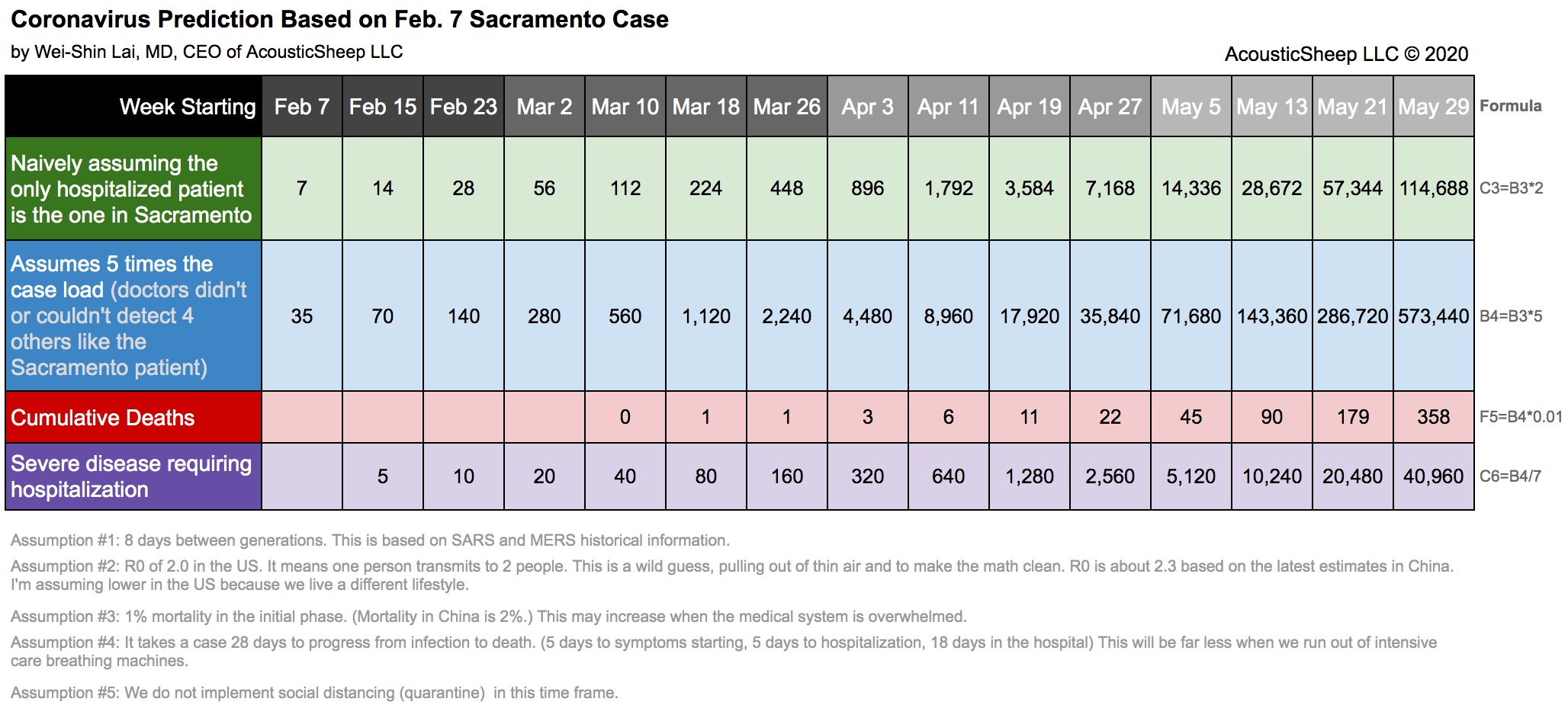
The number of infected patients slightly more than double every 8 days based on the numbers coming from China. (Mid-March models suggest doubling every 7 days.)
I cannot predict what the U.S. government will do. I can't say when they will implement a quarantine and to what extent. If I were in charge, I would already have issued clear travel advisements and discouraged social gatherings. I would also have been transparent with the rough math I just did out there for real epidemiologists to hammer out. I would have full transparency for all projections to justify why we ask people to sacrifice some personal liberties to save their own grandparents.
Coronavirus Prediction and Timeline
My best guess for what the timeline looks like is this. We will see a sharp rise in confirmed cases in early March, but it will seem small when continually compared with the flu. By mid-March (February), all major cities will have infected people but not necessarily confirmed cases. By late-March (late-February), there will be confirmed cases in all major cities, and we'll start to see deaths. By the end of April (end of March), the healthcare system will be strained in specific areas (Seattle, NYC suburb of New Rochelle/Westchester County), and we will see a rise in deaths. People will be afraid, and even without a mandated quarantine, some people will essentially self-quarantine when the disease is in their area. 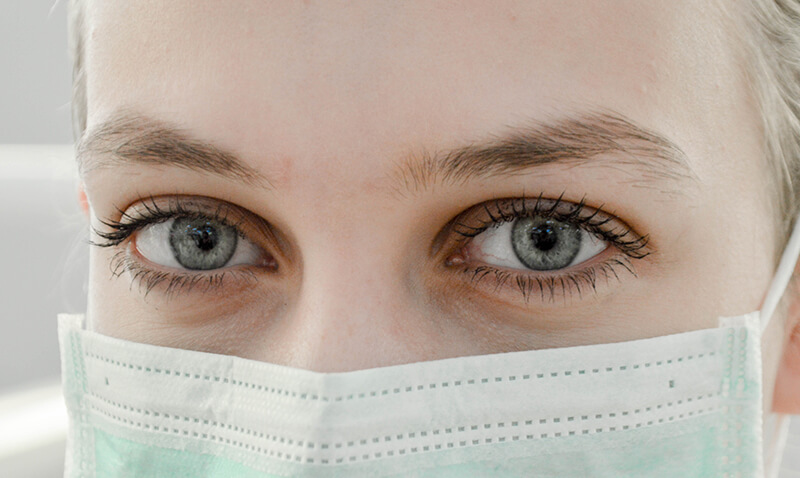 Closure of schools and some businesses will cause an economic slow down. There will be slight disruption up and down the supply chain, though we'll still get our Prime packages and have fresh food in our grocery stores. We will begin to get used to this new norm, which will last through at least May. The spike in deaths will begin in
Closure of schools and some businesses will cause an economic slow down. There will be slight disruption up and down the supply chain, though we'll still get our Prime packages and have fresh food in our grocery stores. We will begin to get used to this new norm, which will last through at least May. The spike in deaths will begin in May (April). In June May, over 1 million people in the US will have been infected even with our current level of social distancing. Schools and universities will continue to be online for the rest of the school year. The entire world's children will miss a quarter of a year of in-person school and spend "quality time" with frazzled parents suffering economic hardship, which will be a formative phase of their life. We can choose to set good examples for our children by helping each other through hard times rather than complaining about toilet paper hoarders and pointing xenophobic fingers. There may be a few daring summer camps, limited in size, with lots of restrictions. Working from home will last until we have efficient testing in place. Once we can quickly detect and isolate, we can allow people to gradually return to work, with changes to social distance, meetings, and hygiene.
School will resume in the fall, and we will feel like life is returning to a new normal again. Some social distancing measures will remain in place, especially for large gatherings, concerts, gyms, buffets, and cruise ships. Travel by plane will be low because of social distancing, but since the pandemic is making its tsunami hit in March-May, there would be no use to restrict international travel anymore. For hospitals, the gradual decline in new cases over the summer will finally feel like we can breathe again. We will have dedicated hospitals or sections of hospitals to continue coronavirus care, with segregated staffing that recovered already from the infection. Speaking of recovered people, they would help to act as buffers for transmission of virus. The spread of the virus will slow down significantly as more and more people move from susceptible to infected to recovered. This slowing of spread is called herd immunity, which will allow us to live essentially normal lives again by late 2020.
The virus will continue to spread over the next 1-2 years, until 80% of people have had the infection. We will discover that some people just aren't susceptible or are extremely lucky somehow. We will see a lower mortality rate than China, perhaps closer to 5% 15% of people over 70 years old and 1% 3% for those in their 60's.
After that, the virus will continue to circulate in children, causing nothing more than a cold. We will have a vaccine by then. Because this virus can mutate, even though it's not very severe, we will decide to make it part of the routine childhood vaccine schedule.
I could be wrong. No officials are willing to stake their reputation on a mathematical model. Doctors won't risk their license with wild claims. I'm retired from being a doctor, and I don't mind going out on a limb to provide scientifically-based information.
How Supply Chains Will Be Affected

Part of our supply chain is in China, so I speak with our factories weekly. I speak Mandarin and have a great relationship with our people there. I think I'm getting reliable intel from them. They joke that you know your temperature from hour to hour because there is a guard scanning you between factory floors, at building entrances, at various traffic stops, etc. Exits from buildings are blocked off by large boards so everyone has to pass through the screening checkpoint. To travel from your hometown to a factory for work requires multiple layers of documentation such as a note from a doctor, proof of work, the tickets for the entire trip, and other bureaucracy. What the Chinese have done with their quarantines is absolutely astounding and as comprehensive as one can hope. Only an authoritarian government top heavy with agents can pull it off. It's truly amazing.
But it was too late. The lower level government officials who initially covered it up allowed it to blow up too far. The reason why the number of cases are going down in China is because they are now really trying and doing a great job identifying cases and immediately quarantining everything.
While the factories are now technically open again in Shenzhen, staffing is at 20-40% because workers can't get there or are afraid to leave home. Factories aren't able to produce anything if they can't get supplies (paper, metal, plastic) from their suppliers. If anyone has a fever, the entire company is shut down until the test results come back.
Meanwhile, the government is mandating that companies continue to pay their employees, and Beijing recently announced some monetary relief. Still, some companies won't be able to weather this and will shut down.
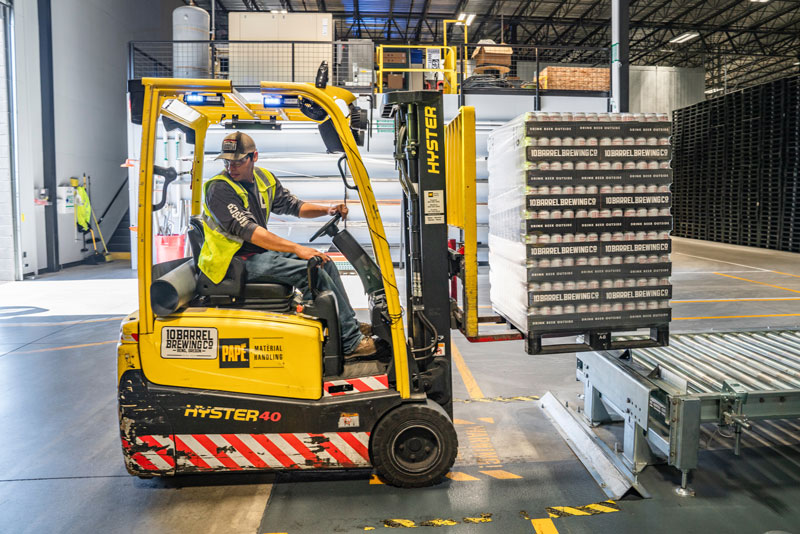
If any part of your supply chain is in China, you already know this is a big problem. Consumer electronics are almost exclusively made in China. We don't know when our battery factory will get to our order, and that's holding things up downstream. A well-run company would have inventory level for 2-3 months. If China doesn’t resume production soon, there will be shortages for some brands. Apple has shifted some manufacturing to Taiwan but even a fantastic second source backup company may not be able to ramp up that quickly. Many components are only made in China, where production remains spotty.
What Should I Do About My Travel Plans?
If you have Spring Break plans, you might drive instead of fly. If you get airline tickets, consider buying travel insurance that does not specifically exclude epidemics. Personally, I would no longer travel after mid-March by plane not because I'm afraid of catching it but because I wouldn't want to be "the one" who brings it to my community.
Meetings and Corporate Gatherings
If you have a meeting or corporate gathering scheduled in March or April, consider canceling it, if possible, because it would be the responsible thing to do for public health. If it's in May, you may have no choice but to cancel and come up with another way to accomplish the same goals.
There may be travel restrictions. My cousin flew to Rwanda last weekend. She has a Taiwanese passport even though she lives in the US. They pulled her out for screening. They followed absolutely no infection control procedures for testing her and the dozen other people they bussed from the airport to the hospital and back.
Long-Term Societal Change
The chart for death rate by age group is very clear. Older people are more likely to die. Some risk factors currently known to contribute to a worse outcome include heart disease, lung disease (COPD, asthma, smoking), and diabetes. Out of over 70,000 known infected people, not one in the 0-9 age group has died. One in ten elderly persons may die from this in the US.
Young children will get it every year and be fine. Epidemiologists looking way into the future say it will become just another circulating cold virus that most children get and recover from. There are many of those. Most kids get RSV in their first 2 years, and it's a bad cold. For a long time before the vaccines, most kids got rotavirus or chickenpox. They caused probably worse illness than this for children and still managed to exist as an organism.
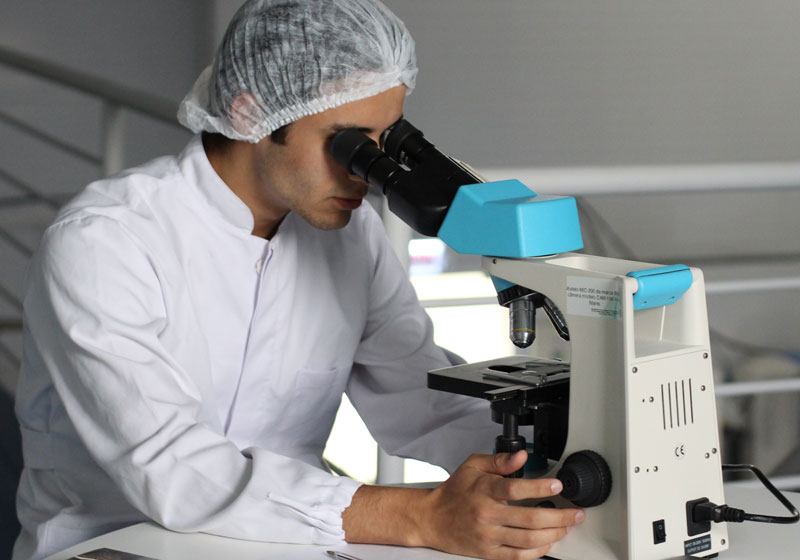
This virus actually is extraordinary evolutionary. It will continue to survive (propagating its genes) because it will always have new people to infect (children) while not killing them. It's an RNA virus. RNA is single stranded unlike DNA. With double stranding, there is redundancy, and mutations are less likely. With RNA, there is no redundancy, so mutations are more likely. It will mutate over time as it circulates in the human population. So it may get weaker (causing less severe illness) over time, but because of the rapid mutations, there will be spin-offs that are sometimes worse. I expect that because of this, we will finish developing this vaccine, and it will become part of the routine vaccination schedule.
Economics and Business Impact
A quarantine will definitely affect supply chain and slow down growth. That would be the main thing that determines how much of a recession we experience. Since most working-age people won't die, the capacity to resume growth will recover smoothly, but it may be several months to restart the engine once this blows through.
Creating a Business Continuity Plan for the Coronavirus Outbreak
The CDC provides excellent guidance on this page for what businesses need to do to prepare.
This in addition to what the CDC recommends.
Brief your employees on what to expect for your business.
- Give your employees an update on how the coming global slowdown will affect your industry. If you don't have guidance from your industry groups, consider what losing 10-15% of the elderly would mean to your industry.
- Reassure them that the coming economic slowdown will likely be "brief," perhaps a year, and unlike the 2008 recession.
- If part of your supply chain is in China, provide an update on inventory levels. You may not want to run any sales if you will be running low on inventory. My prediction is that China will be up and running at 80% again by April.

Plan to have employees work from home at some point for 2-4 weeks when the disease is in your community. You may only have 2-3 days of notice to implement this, so you should be prepared.
When your local municipality tells people to work from home, kids may already be home. You may have already received a note from your school about this possibility- I have. Workers with young children won't be able to work at full capacity with kids running around at home. You may consider an HR policy for this.
I think that shutting down the economy for 4 weeks would really stretch our resources, so I can't imagine more than a month of quarantine conditions. A quarantine in the US would not look like China. I'm sure many exceptions will be made, and true needs will be met.
I'll have to check our insurance policy to see if it specifically excludes pandemics from business continuity losses, but I seem to recall nervously chuckling with our insurance agent about it. Oh well.
Feel free to share my list for personal planning with your employees.
Personal Planning
Here are some suggestions for what you will need personally to prepare.
Prescription medicines: A three month supply is ideal but you should have at least enough for a month. Your doctor or pharmacist may be busy, the pharmacy may run out due to supply chain issues, or you may have trouble getting to the pharmacy with a strict quarantine. In China, some people on heart medications died because they couldn't leave their building to refresh their medicines. Some medications depend on components from other countries. Consider contact lenses and glasses as well.
Non-prescription medicines: If you do end up catching the coronavirus, you may experience cold symptoms. So whatever you like taking for a bad cold would be useful to have around. Some people like cough drops, decongestants, nose sprays, or pain relievers. Spring allergy season is coming soon, so you may want to pick up those medications early.
Food: About 2 weeks worth for your household and pets is a good start. Frozen or canned foods are useful when you run out of fresh foods. I'm sure we'll pull together in a community, and no one will starve in their own residence. Don't buy anything you wouldn't normally eat. Just store a little more of what you would eat that's not perishable and keep eating through it over time.
Disposable paper products: Routine necessities may include paper towels, toilet paper, diapers, and feminine hygiene products.
Cleaning supplies: It's always useful to have plain bleach around. It's cheap, and in a doomsday scenario, it's very versatile. With two kids, we generate a load of laundry and dishes daily, along with a 13 gallon bag of trash, so have enough of those for a month or two.
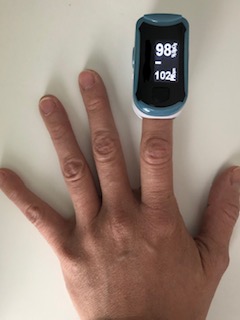
Medical supplies: A thermometer is important. If you can afford it, a pulse oximeter is helpful too. If you feel short of breath, monitoring your blood oxygen level over time may help your doctor determine when you should go to the hospital.
Face masks are overrated. There are 2 main types that you will encounter- surgical masks and N95 respirators. Cheap surgical masks don't filter air well. Air comes in from the sides when you inhale, so they won't really protect you from breathing in airborne virus particles. They do, however, limit a sick person's ability to spread germs from coughing or sneezing. If you are in a high-risk environment, they are better than nothing. If you can't buy any, I wouldn't get bent out of shape about it.
As for N95 masks, you probably don't know how to wear them correctly unless you are in the healthcare field. For healthcare workers, proper N95 fittings are recommended yearly and when you gain or lose weight. In one test, you have to count to 20 while a nurse sprays a scent. If you end up detecting the scent, then the seal is not good enough. It often takes several tries to find a good-fitting N95 mask. When properly fitted, they are uncomfortable to keep on for more than 10 minutes. You may feel claustrophobic because they restrict air exchange so much. Talking without breaking the seal is hard, and exertion such as walking through an airport is exhausting. There may be a shortage even for healthcare workers, so please don't hoard these and then waste them.
Disposable latex or nitrile gloves: In case you need to come into contact temporarily with potentially infected material, these would be handy. You can even use alcohol sanitizer over them. But once they become sticky with visible grime, either dispose of them or wash them thoroughly with soap and water (while wearing), just like you would with your hands. FYI, no medical professionals in the US would ever sanitize gloves with alcohol or soap and water. But if you have a limited supply, this would be an acceptable solution, in my opinion. Fabric gloves work for temporary situations too and can be easily cleaned with the rest of your laundry. If you can't find any, don't panic. Just wash your hands thoroughly after handling the material.
Basically, as you go through your day, keep a mental note of things you use up daily. Then make sure you have enough for 2-4 weeks so that you wouldn't be inconvenienced. Don't buy things just to hoard them with the plan to return them later. That's not neighborly. The quarantine may be weeks away, may be months away, or it may never happen. And when it happens, it may not be very restrictive. There's no need to be stuck with credit card bills and a bunch of stuff you don't actually like to eat or use.
-My qualifications are as follows:
Dr. Wei-Shin Lai
- 2016 Small Business Entrepreneur of the Year in PA (SBA) and many other entrepreneur and product awards
- Saw patients for 10 years as a board-certified family doctor
- Offered job as an Epidemic Intelligence Officer at the CDC
- Graduated from the University of Virginia Medical School
- Graduated from the University of Michigan with a B.S. in Cellular Molecular Biology
- Worked in 6 science labs for 6 summers
- Received a 5 on the AP Calculus BC exam as a junior in high school, running out of math to take in high school
References
- https://www.cdc.gov/coronavirus/2019-ncov/index.html
- https://www.who.int/emergencies/diseases/novel-coronavirus-2019
- https://jamanetwork.com/journals/jama/fullarticle/2762130
- https://academic.oup.com/jtm/advance-article/doi/10.1093/jtm/taaa021/5735319
- https://www.thelancet.com/journals/lancet/article/PIIS0140-6736(20)30260-9/fulltext

